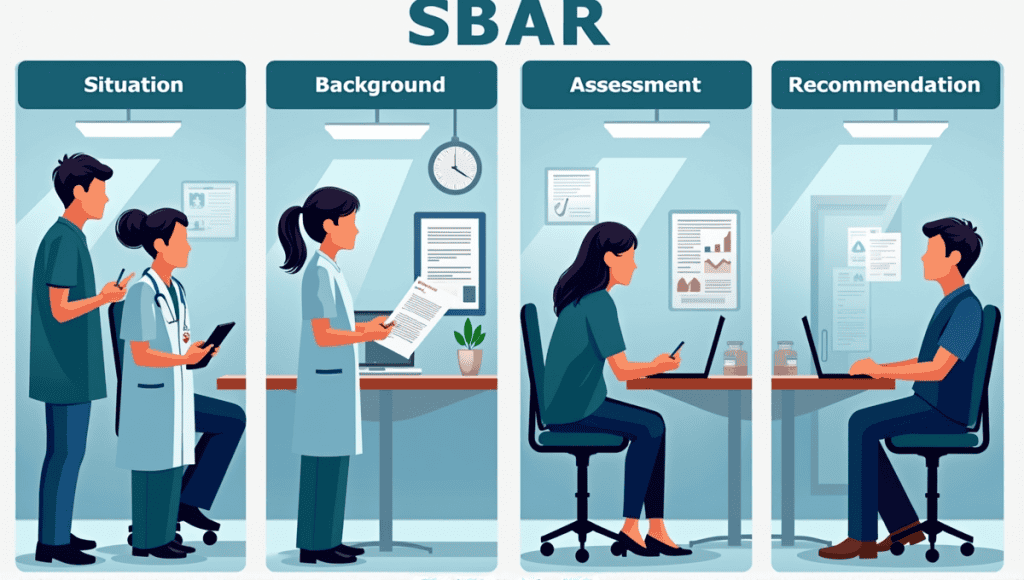SBAR enhances communication by offering a structured format to communicate key details. As a former lean management consultant, I’ve witnessed the impact this tool can have on improving workflow efficiency in healthcare and other industries. SBAR stands for Situation-Background-Assessment-Recommendation.
It helps guarantee all relevant information is communicated in a clear, concise manner, minimizing errors and improving decision making.
What is SBAR?

SBAR is a structured method to communicate key information. It ensures that you deliver the most important information in a logical, organized fashion. I’ve even seen it used in various industries outside of healthcare, including manufacturing and project management. For instance, process optimization in project management can greatly benefit from using structured communication.
The purpose of SBAR is to improve communication, particularly in high-stakes or time-sensitive situations. It allows you to quickly communicate the most important information so others can make a decision. It prevents miscommunication by providing a consistent framework to communicate information.
In my experience, It is most useful in healthcare. Healthcare professionals use it to communicate patient care among doctors, nurses, and other medical staff. However, I’ve also used SBAR in manufacturing plants to communicate production issues and in project management for communicating status information.
Advantages of Structured Communication

One of the primary benefits is improved communication clarity. The structured communication framework ensures all of the relevant details are communicated, which in turn reduces errors and misinterpretations, particularly in high-stakes environments.
In healthcare, using It improves patient safety. It ensures that the person you’re speaking to has all of the important details about the patient’s condition, which can then help them make the right interventions more quickly. Additionally, employing lean tools can enhance efficiency in communication processes.
It also makes information transfer more efficient because you can communicate the main points in a short amount of time without irrelevant details. This is critical in any time-sensitive setting where quick decisions need to be made.
Using SBAR also standardizes communication processes, as everyone will communicate using the same framework. This makes information easier to communicate and easier to understand across teams or departments. This consistency is helpful in larger organizations and/or when communicating across different facilities.
Elements of Effective Medical Communication

Situation:
- Who you are and who the patient/subject is
- What the problem is and why you’re calling
Background:
- Relevant history
- Pertinent details about the present situation
- Any similar past situations or ongoing issues
Assessment:
- Your evaluation of the situation
- What you think is happening
- Data or observations to back up your assessment
Recommendation
- What you think should be done
- Specifically, what you want done
- A timeframe if applicable
- Ask for agreement/feedback
Using this structure ensures you don’t forget any important details, and it also makes it easier for the recipient to understand and take action on the information you’re providing. For example, using decision tree analysis can help in evaluating situations effectively.
When to Use SBAR
Its is a general framework, and you can use it in many different situations. However, there are a few situations where the SBAR framework particularly shines.
Any urgent situation that requires immediate action is a great use case for SBAR. You can deliver key information in just a few seconds, and the other person can deliver the response you need right away.
Shift handovers are another great opportunity to use it. It ensures that you accurately communicate vital patient information from one team to the other.
When transferring the patient to a different department or a different hospital, using it ensures that relevant patient information isn’t missed.
Patient condition changes are incredibly common in a hospital. SBAR provides a framework to communicate this information as efficiently as possible to the provider.
In my consulting business, I’ve used it for status updates in project management. It helps you deliver a quick snapshot of where things stand, where you’re stuck, and what the next step should be. Implementing techniques like benchmarking best practices can also enhance these updates.
A study of an internal medicine unit found that only 3% of urgent text messages from nurses to doctors included all four pieces of SBAR. Clearly, there’s a lot of room for improvement in consistently using this framework.
How to Implement SBAR

Train the staff on how to use it. Teach them the components and benefits of SBAR and provide relevant examples for your industry or department.
Develop tools (physical forms, digital interfaces, smartphone apps) that help users complete each component of SBAR.
Integrate it into the communication infrastructure. This could require updating protocols or adding fields to the software the team uses to communicate.
Have the team practice using SBAR and role play to ensure everyone is comfortable with the approach. Then, hold regular feedback meetings to continuously improve.
Measure the impact of using it (e.g., communication errors, response time) and continue optimizing your tools as a result.
Optimal Techniques for Clear Medical Handoffs

Conciseness. Don’t ramble or include details that don’t matter. Keep the message short and to the point.
Use plain, non-technical English. This is particularly important if you and your audience are from different medical specialties or departments.
Active listening. When you receive (or give) an SBAR communication, listen carefully to the message. If you don’t understand, ask questions to clarify the message.
Confirm understanding. When you receive an SBAR communication, repeat the key points back to the sender to ensure you both have the same understanding of the situation.
Document SBAR communications. Recording these communications provides a record and is helpful for quality improvement projects.
Iterate on the SBAR process. Ask users what’s working and what needs improvement. Then, make changes and try again.
One study looking at SBAR implementation found a substantial increase in resilience scores post intervention. Pre-intervention, resilience scores were 28.03 ± 3.96, and post-intervention, the scores were 38.46 ± 4.62. This is evidence that implementing it has a positive impact on team performance and communication.
Let’s Close This Out
SBAR is a valuable communication tool in high-stakes environments. I’ve witnessed its effectiveness in manufacturing and healthcare, and it significantly reduces confusion and improves outcomes. You can implement it today to enhance your team’s communication.
Just remember that like any skill, the more you practice using it, the better you’ll become. And the clarity and efficiency that your coworkers (or patients) will receive are well worth the minimal effort to master it.






